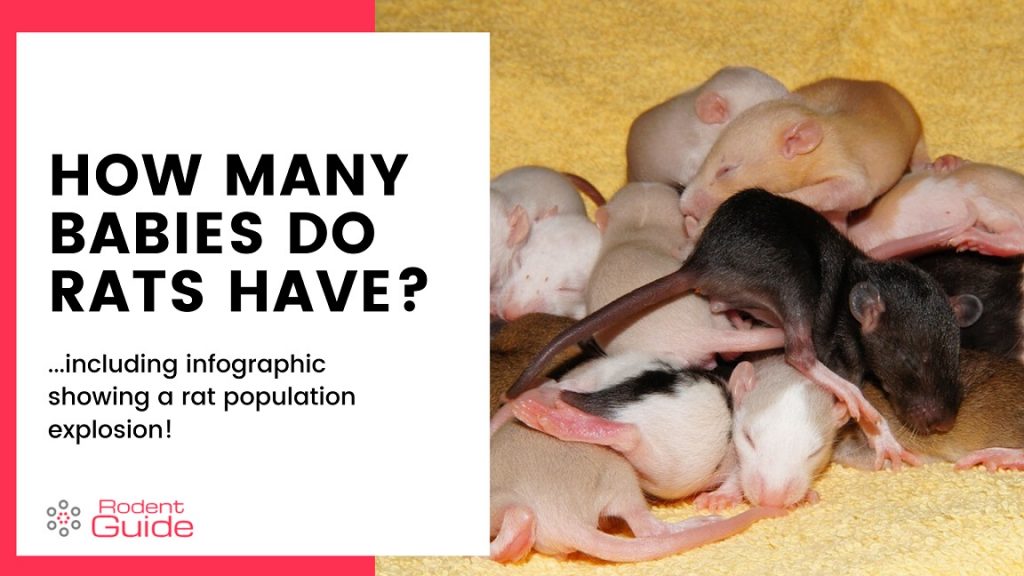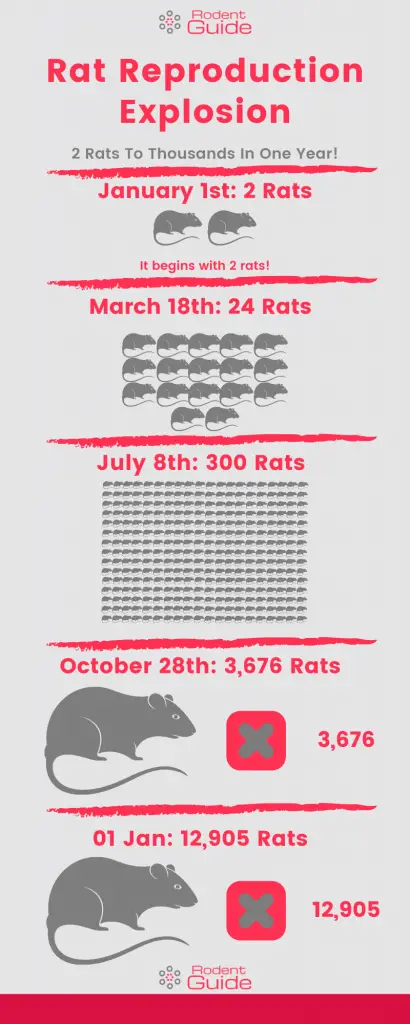Brace yourself! This post contains an infographic highlighting how one rat can turn into THOUSANDS in ONE YEAR!
It is very concerning just how quickly these rodents can reproduce! But, it begins with one question: How many babies do rats have? In this post, we are going to answer that question!
Rats are dangerous, they spread diseases, and they can multiply like wet gremlins (ok, it was the mogwai that multiplied, but you know what I mean).
What you will learn in this post:
- How many babies do rats have?
- How many rats can 2 create in 1 year?

How Many Babies Do Rats Have?
Ok, there are tons of different species of rats throughout the US and the rest of the world. The most common rat is called the Norway Rat (Brown Rat). It has other names, including:
- Sewer rat
- Street rat
- Common rat
And many others!
As the Norway rat is the most common, we will take a look at how many babies a Norway rat can have. Then we will look at how many they can produce in just 1 year!
Other species of rats will have similar statistics to the Norway rat, and as it is the most common, it makes sense to use it in this example.
Norway Rat Litter Stats
- Minimum: approx. 3
- Maximum: approx. 20
- Average: approx. 7
So, how many babies can a rat have? Up to approximately 20, and the average is around 7. Simple question, simple answer!
But I don’t want to stop there! I want to show you how 2 rats (male + female) can turn into thousands of rats in just 12 months. Turn away now if you are squeamish!
Rats – A Reproducing Machine
Before I begin the calculation, I want to get some facts down for your entertainment.
- Average Gestation Period (Norway Rat): 21 Days
- Average Time To Sexual Maturity (Norway Rat): 35 Days
- Average Litters Per Year (Norway Rat): 5
Now that we have those details in the bag let’s look at the math.
Ok. On January 1st, we begin with 2 rats. 1 male, 1 female. The female get’s pregnant.
It takes 21 days from conception to birth. Therefore, on January 22nd, we have (considering the average little size of 7) 3.5 males and 3.5 females.
Now we have 4.5 females (including mamma rat) and 3.5 males.
As I mentioned above, there are 35 days before the 3.5 new female rats reach sexual maturity. Let’s say they get pregnant straight away (because they can). That means the number of females increases by 3.5 every 8 weeks (21 days gestation period + 35 days to reach sexual maturity).
With me so far? Yes, good!
357 Day Walk-through – Rat Population Explosion
So – deep breath – let’s look at the first 24 weeks since the initial litter was born (on January 22nd).
- January 22nd: 3.5 females
- March 18th: 12.25 females
- May 13th: 42.875 females
It doesn’t look too bad so far. Although I would want that many rats in my home! It’s time to expand a little further:
- July 8th: 150 females
- September 2nd: 525.22 females
- October 28th: 1,838.26 females
We can fit 1 more 8-week period into the 12 months:
- December 23rd: 6,433.93 females
Let’s not forget this number does not include the original 2 mice or the males. Assuming they carried on producing, they would have had 5 litters of 7 mice on average during this time.
These are just females. You can double that number for the total number of rats from January 1st – December 23rd!
That is 12,868 + 2 original rats + their additional litters throughout the year (35)
Total rats: 12,905.
I am more about graphics than words, so here is an infographic of the rat population explosion.

I am sure that answers the question: how many babies do rats have?
Frequently Asked Questions
How many babies can a rat have at once?
A female rat can have up to 20 baby rats per litter. However, the average litter size is 7. It is easy to see why there are so many rats on this planet.
How often do rats reproduce?
A female rat will produce up to 5 litters per year under the right circumstances. The litter sizes are usually between 3 and 20, with an average litter size of 7. It takes 35 days for a rat to reach sexual maturity from birth, and the gestation period is around 21 days.
Do rats eat their babies?
Under certain circumstances, the mother rat will eat her baby. It is thought that rats eat their babies because they are either deformed or dying. The mother rat will eat the young because they know it will only take up valuable resources from the mother, and it is unlikely to live anyway. Underneath this question is a video where you can see this happening.
The following video contains images that may upset some viewers.
Conclusion
If you want to know how many babies rats have, then the answer is simple. It is between 3 and 20, with an average of 7.
Having said that, I wanted to expand on the question to give a further answer: How many rats can be created in 1 year from 2 rats. The number is astonishing!
Although I was using the average over the calculation, it could be a lot more or a lot less. We are working with averages here.
When you consider the number of rats that just 2 can produce, it is clear why our planet has a huge population of rats. Not all of them will invade your home, but it makes you realize how close they must be to your own home.
You can do many things to keep rats away from your home, although it is worth familiarizing yourself with the common noises that indicate that you have rats in your attic or home. Knowing this info will help you get ahead of the game when getting rid of them!
Good luck!







